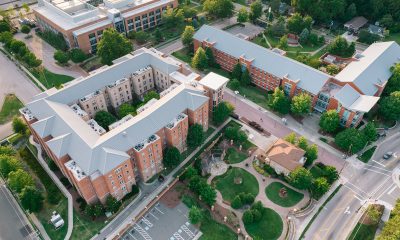Technology
Bomb Threats Shared Electronically Close Schools

In this Jan. 13, 2014 file photo, students pass by Seven Lakes High School after being evacuated and released from school for the day after a bomb squad was called to the school after a potentially explosive device was found. (AP Photo/Pat Sullivan, File)
KIMBERLY HEFLING, AP Education Writer
WASHINGTON (AP) — Tech-savvy students and others are using smartphone apps, social media and Internet phone services to make anonymous reports of bombs and other threats of violence at schools. The result: school evacuations and police sweeps.
In most cases, such a threat turns out to be a hoax. Still, the use of the modern technologies has made it that much harder to determine if a threat is real and to find the culprit, compared to the past when they were often called in by pay phone or written on bathroom walls.
Just this week, a 16-year-old from Gateway High School in Kissimmee, Florida, was arrested for posting about a bomb threat on Twitter because “she was angry and did not want to go to school,” according to the Osceola County Sheriff’s Office.
School safety experts say the number of such incidents appears to be increasing — as are the complexity of the cases. The latest figures from the National Center for Education Statistics for the 2009-2010 school year show 5,700 such disruptions.
“They send a great deal of fear and panic throughout a community,” said Kenneth Trump, a school safety consultant who is president of National School Safety and Security Services. His group reviewed more than 800 threats reported in the media during the first half of the 2014-2015 school year and found that about one-third were sent electronically using text message, social media, email or other online means.
Complicating matters, the threats aren’t just coming from within school walls or even a school’s neighborhood.
Last fall, Lakota Middle School in Federal Way, Washington, was placed in lockdown and police responded after an email purportedly from the Islamic State group demanded ransom money and threatened to “shoot and kill” every American, according to a police report. A 14-year-old student was arrested after admitting the email had been sent by her online friend “Ryan” after she told him to “swat” her school because she thought it would be funny, police said.
“Swatting” plays off the idea of issuing a threat that draws a SWAT team in response, disrupting activities at the target of the threat. It appears to have originated with pranksters in the online gaming community.
In a separate case, a 14-year-old in western Michigan was ordered by a judge to pay nearly $8,000 in restitution to the Coopersville Area Public Schools and the Ottawa County Sheriff’s Office for his involvement in a swatting incident that put schools in lockdown after a caller using computer-based technology made threats against the schools. Authorities say the call was made by a person code-named “Ransom,” whom the teen had met online. “Ransom” is believed to live in the United Kingdom and is suspected in a string of similar incidents from coast to coast, authorities said.
“He will learn from this,” the teen’s father said, according to the Grand Rapids Press in Michigan.
The motivations of the threat makers vary: avoiding a test, revenge or simply to show off. With swatting, a motivation appears to be thrill-seeking, said Capt. Mark Bennett with the Ottawa County Sheriff’s Office.
It’s not too difficult for students to figure out how to pull off such an incident, said Justin Cappos, a computer science professor at New York University who studies cybersecurity. “You wander to the wrong parts of the Internet and you can learn how to do it and not get caught,” Cappos said.
With each incident, there’s a risk when authorities respond, said Detective Jerrad Ely, a digital forensics expert with the Mount Vernon Police Department in Washington who has been investigating a bomb threat case against a school in his community. “They could inadvertently get hurt when police are just trying to do their jobs based on the best information that they have,” he said.
Applications such as Burnbook, Afterschool, Yik Yak, Whisper and Kik also have been used by students to make threats anonymously.
In Michigan, Superintendent Timothy Stein of the Flushing Community Schools wrote to parents in December informing them about a posting on Afterschool that said, “Bringing a Gun to School.” The posting had been brought to the high school principal’s attention by a text message; police quickly determined that it was not a credible threat.
“I encourage you to ask you child to stop using this app and remove it from their phone,” Stein said.
Every threat has to be taken seriously even though in most cases the called-in danger is not real, said David Pennington, superintendent of schools in Ponca City, Oklahoma, and president of the AASA School Superintendents Association.
Meanwhile, social media and other electronic means of communication are keeping parents informed about threats. Mindful of past school shootings, they are demanding that children be pulled out of school even as school and law enforcement officials investigate.
“The security of people has been greatly eroded in this country, as you know, just through awful things that have happened,” said Mark Davidson, deputy superintendent at the Federal Way Public Schools.
_____
Follow Kimberly Hefling on Twitter: http://twitter.com/khefling
Copyright 2015 The Associated Press. All rights reserved. This material may not be published, broadcast, rewritten or redistributed.
Community
Attorney General Rob Bonta, Oakland Lawmakers, Introduce Legislation to Protect Youth Online
At a press conference in downtown Oakland on Jan. 29, Attorney General Rob Bonta joined Sen. Nancy Skinner (D-Berkeley) and Assemblymember Buffy Wicks (D-Oakland) to announce two pieces of legislation designed to protect children online. The bills are Senate Bill (SB) 976, the Protecting Youth from Social Media Addiction Act and Assembly Bill (AB) 1949, the California Children’s Data Privacy Act.

By Magaly Muñoz
At a press conference in downtown Oakland on Jan. 29, Attorney General Rob Bonta joined Sen. Nancy Skinner (D-Berkeley) and Assemblymember Buffy Wicks (D-Oakland) to announce two pieces of legislation designed to protect children online.
The bills are Senate Bill (SB) 976, the Protecting Youth from Social Media Addiction Act and Assembly Bill (AB) 1949, the California Children’s Data Privacy Act.
Skinner authored SB 976, which addresses online addiction affecting teenage users, while Wicks’s bill, AB 1949, takes on big tech by proposing data privacy and children rights protections.
“Social media companies unfortunately show us time and time again that they are all too willing to ignore the detriment to our children, the pain to our children, the mental health and physical challenges they face, in order to pursue profits,” Bonta said.
SB 976 would allow parents to control the nature and frequency of the content their under-18-year-old children see on social media. Notifications from social media platforms would also be paused from midnight to 6 am and controls would allow parents to set time limits on their children’s usage based on their discretion.
Skinner stated that the longer that kids are on their phones during the day, the higher the risk for depression, anxiety and other related issues.
The bill would also push to get rid of addictive media that is harmful for young women and girls, specifically image filters that mimic cosmetic plastic surgery.
Bonta and 33 other attorney generals had previously filed a lawsuit against Meta, owner of the popular social media applications Instagram and Facebook. The filing claims that the company purposefully uses algorithmized content that harms younger audiences.
“Social media companies have the ability to protect our kids, they could act, but they do not,” Skinner said.
The Child Data Privacy Act would strengthen existing protections for data privacy under the California Consumer Privacy Act (CCPA). The lawmakers argue that the law does not have effective protection for those under 18 years old.
Wicks stated that the bill would forbid businesses from collecting, using, sharing, or selling personal data of anyone underage unless they receive informed consent, or it becomes necessary for the purpose of the business.
Wicks added that the acts would make it so that a search on the internet like “How do I lose weight?” would not result in dieting pill advertisements targeting youth, which, some experts report, could be harmful to their mental and physical health.
“In a digital age where the vulnerabilities of young users are continually exploited, we cannot afford to let our laws lag behind, our children deserve complete assurance that their online experience will be safeguarded from invasive practices,” Wicks said.
Supporters of the two acts say they have gained bipartisan support issue, but the authors and Bonta expect them to be met with pushback from the affected companies.
#NNPA BlackPress
Unleashing the Power_ Discover the The Thrills…F-TYPE Convertible
Performance & Handling Powered by a robust 5.0 Liter Supercharged 8 Cylinder Gas Engine, the F-Type R75 doesn’t just purr; it roars with a mighty 575 horsepower and 516 lb-ft of torque. Coupled with an 8-speed Automatic Transmission, the car offers an exhilarating drive that is both fast and smooth. The All-Wheel Drive system ensures […]
The post Unleashing the Power_ Discover the The Thrills…F-TYPE Convertible first appeared on BlackPressUSA.

Performance & Handling
Powered by a robust 5.0 Liter Supercharged 8 Cylinder Gas Engine, the F-Type R75 doesn’t just purr; it roars with a mighty 575 horsepower and 516 lb-ft of torque. Coupled with an 8-speed Automatic Transmission, the car offers an exhilarating drive that is both fast and smooth. The All-Wheel Drive system ensures excellent traction and stability, making it a joy to handle in various driving conditions. The Electric Power Assisted Steering and JaguarDrive Control with Selectable Driving Modes add to the car’s agility, providing a driving experience that is as intuitive as it is thrilling. Additionally, the Adaptive Dynamics and Electronic Active Differential with Torque Vectoring by Braking enhance the car’s responsiveness, making every turn a testament to its engineering prowess. Unique to AutoNetwork.com.
with Selectable Driving Modes add to the car’s agility, providing a driving experience that is as intuitive as it is thrilling. Additionally, the Adaptive Dynamics and Electronic Active Differential with Torque Vectoring by Braking enhance the car’s responsiveness, making every turn a testament to its engineering prowess. Unique to AutoNetwork.com.
Like us on and share https://www.facebook.com/autonetwork
#AutoNetwork
#AutoNetworkReports
Subscribe to our channel now for more videos.
Twitter http://www.twitter.com/liveautos
LinkedIn http://www.linkedin.com/in/autonetwork
Coupons Offers and Deals https://www.couponsoffersanddeals.com/
The post Unleashing the Power_ Discover the The Thrills…F-TYPE Convertible first appeared on BlackPressUSA.
#NNPA BlackPress
Elevate Your Ride…
Join us for a virtual car’s best-detailed walkaround of the sleek and stylish 2024 Jaguar F-TYPE AWD convertible. Get an up-close look at the exterior design, interior features, and performance capabilities of this luxury sports car. From its powerful engine to its advanced technology, this video will give you a comprehensive overview of what makes […]
The post Elevate Your Ride… first appeared on BlackPressUSA.

Join us for a virtual car’s best-detailed walkaround of the sleek and stylish 2024 Jaguar F-TYPE AWD convertible. Get an up-close look at the exterior design, interior features, and performance capabilities of this luxury sports car. From its powerful engine to its advanced technology, this video will give you a comprehensive overview of what makes the F-TYPE AWD convertible stand out on the road. Unique to AutoNetwork.com.
Like us on and share https://www.facebook.com/autonetwork
#AutoNetwork
#AutoNetworkReports
Subscribe to our channel now for more videos.
Twitter http://www.twitter.com/liveautos
LinkedIn http://www.linkedin.com/in/autonetwork
Coupons Offers and Deals https://www.couponsoffersanddeals.com/
The post Elevate Your Ride… first appeared on BlackPressUSA.
-

 Activism4 weeks ago
Activism4 weeks agoOakland Post: Week of March 20 – 26, 2024
-

 #NNPA BlackPress3 weeks ago
#NNPA BlackPress3 weeks agoCOMMENTARY: D.C. Crime Bill Fails to Address Root Causes of Violence and Incarceration
-

 #NNPA BlackPress3 weeks ago
#NNPA BlackPress3 weeks agoMayor, City Council President React to May 31 Closing of Birmingham-Southern College
-

 #NNPA BlackPress3 weeks ago
#NNPA BlackPress3 weeks agoCOMMENTARY: Lady Day and The Lights!
-

 #NNPA BlackPress3 weeks ago
#NNPA BlackPress3 weeks agoFrom Raids to Revelations: The Dark Turn in Sean ‘Diddy’ Combs’ Saga
-

 #NNPA BlackPress3 weeks ago
#NNPA BlackPress3 weeks agoBaltimore Key Bridge Catastrophe: A City’s Heartbreak and a Nation’s Alarm
-

 #NNPA BlackPress3 weeks ago
#NNPA BlackPress3 weeks agoBaltimore’s Key Bridge Struck by Ship, Collapses into Water
-

 Activism3 weeks ago
Activism3 weeks agoOakland Post: Week of March 27 – April 2, 2024


















































